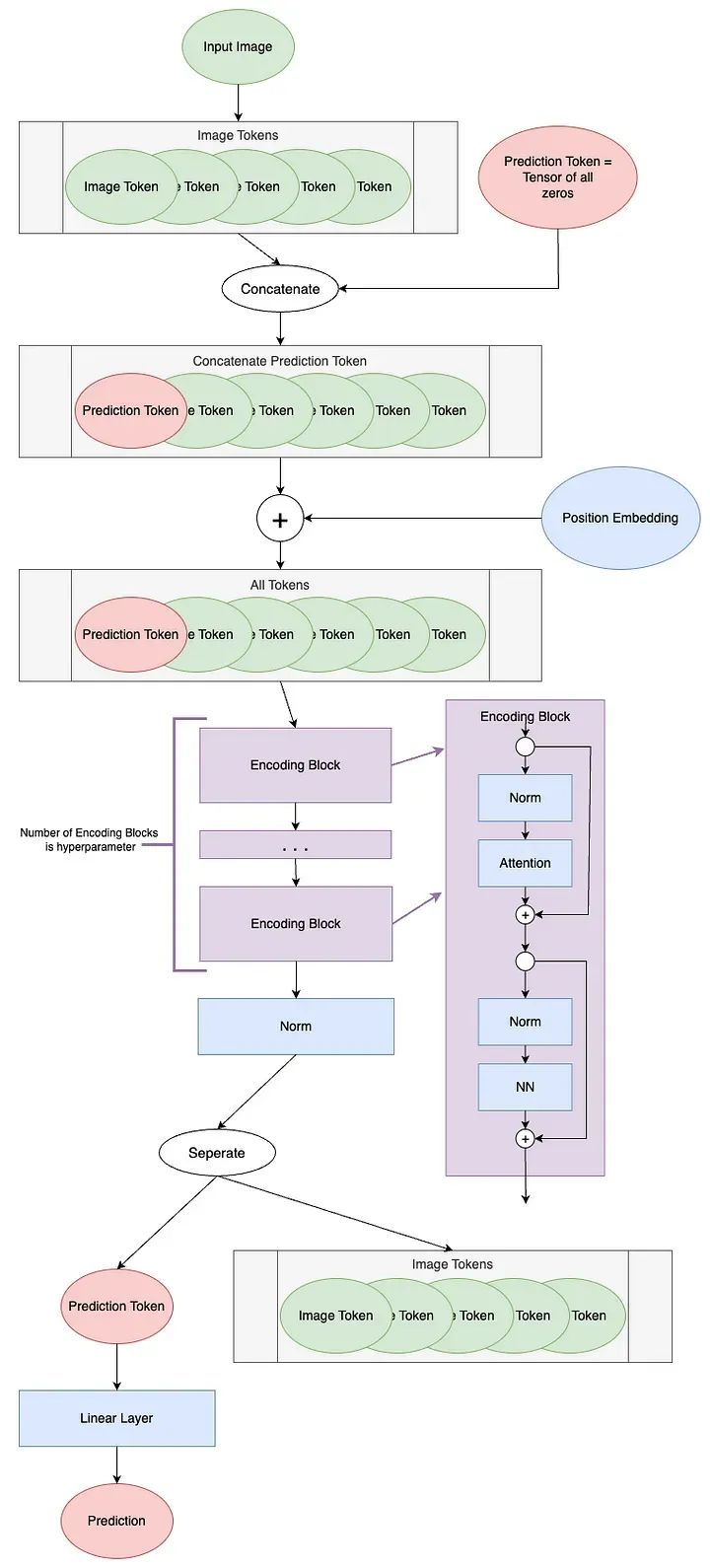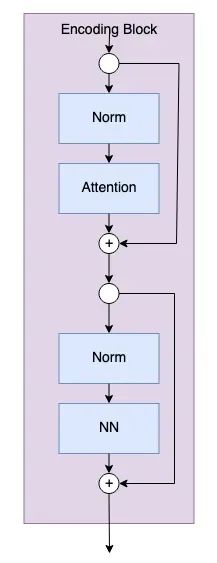自2017年“注意力就是一切”的理念问世以来,Transformer模型便迅速在自然语言处理(NLP)领域崭露头角,确立了其领先地位。到了2021年,“一张图片等于16x16个单词”的理念成功将Transformer模型引入计算机视觉任务中。自此之后,众多基于Transformer的架构纷纷涌现,应用于计算机视觉领域。
本文将详细介绍“一张图片等于16x16个单词”中阐述的Vision Transformer(ViT),包括其开源代码和对各组件的概念解释。所有代码均使用PyTorch Python包实现。
本文作为一系列深入研究Vision Transformers内部工作原理的文章之一,提供了可执行代码的Jupyter Notebook版本。系列中的其他文章还包括:Vision Transformers解析、注意力机制在Vision Transformers中的应用、Vision Transformers的位置编码解析、Tokens-to-Token Vision Transformers解析以及Vision Transformers解析系列的GitHub仓库等。
那么,什么是Vision Transformers呢?正如“注意力就是一切”所介绍的,Transformer是一种利用注意力机制作为主要学习机制的机器学习模型。它迅速成为序列到序列任务(如语言翻译)的领先技术。
“一张图片等于16x16个单词”成功地改进了[1]中提出的Transformer,使其能够应对图像分类任务,从而催生了Vision Transformer(ViT)。ViT与[1]中的Transformer一样,基于注意力机制。不过,与用于NLP任务的Transformer包含编码器和解码器两个注意力分支不同,ViT仅使用编码器。编码器的输出随后传递给神经网络“头”进行预测。
然而,“一张图片等于16x16个单词”中实现的ViT存在一个缺点,即其最佳性能需要在大型数据集上进行预训练。最佳模型是在专有的JFT-300M数据集上预训练的。而在较小的开源ImageNet-21k数据集上进行预训练的模型,其性能与最先进的卷积ResNet模型相当。
Tokens-to-Token ViT: Training Vision Transformers from Scratch on ImageNet则试图通过引入一种新颖的预处理方法,将输入图像转换为一系列token,从而消除这种预训练要求。有关此方法的更多信息,请查阅相关资料。在本文中,我们将重点讨论“一张图片等于16x16个单词”中实现的ViT。
本文遵循《一张图片等于16x16个单词》中概述的模型结构。然而,该论文的代码并未公开发布。最近的《Tokens-to-Token ViT》中的代码可在GitHub上找到。Tokens-to-Token ViT(T2T-ViT)模型在普通ViT骨干结构前添加了一个Tokens-to-Token(T2T)模块。本文中的代码基于《Tokens-to-Token ViT》GitHub代码中的ViT组件。本文对代码进行了修改,以允许非方形输入图像,并移除了dropout层。
ViT模型示意图
ViT的第一步是从输入图像创建Token。Transformer操作的是一系列Token;在NLP中,这通常是一个句子的单词。对于计算机视觉来说,如何将输入分段成Token并不太明确。
ViT将图像转换为Token,以便每个Token表示图像的一个局部区域(或补丁)。他们描述了如何将高度H、宽度W和通道数C的图像重新塑造为N个补丁大小为P的Token:
每个Token的长度为P²*C。
让我们以此像素艺术《黄昏下的山》(作者Luis Zuno)为例进行补丁Token化。原始艺术品已被裁剪并转换为单通道图像。这意味着每个像素的值在0到1之间。单通道图像通常以灰度显示,但我们将以紫色配色方案显示它,因为这样更容易看到。请注意,补丁Token化不包括在[3]相关的代码中。
mountains = np.load(os.path.join(figure_path, 'mountains.npy'))
H = mountains.shape[0]W = mountains.shape[1]print('Mountain at Dusk is H =', H, 'and W =', W, 'pixels.')print('\n')
fig = plt.figure(figsize=(10,6))plt.imshow(mountains, cmap='Purples_r')plt.xticks(np.arange(-0.5, W+1, 10), labels=np.arange(0, W+1, 10))plt.yticks(np.arange(-0.5, H+1, 10), labels=np.arange(0, H+1, 10))plt.clim([0,1])cbar_ax = fig.add_axes([0.95, .11, 0.05, 0.77])plt.clim([0, 1])plt.colorbar(cax=cbar_ax);#plt.savefig(os.path.join(figure_path, 'mountains.png'))
Mountain at Dusk is H = 60 and W = 100 pixels.
这个图像的高度为H=60,宽度为W=100。我们将设置P=20,因为它能够均匀地整除H和W。P = 20N = int((H*W)/(P**2))print('There will be', N, 'patches, each', P, 'by', str(P)+'.')print('\n')
fig = plt.figure(figsize=(10,6))plt.imshow(mountains, cmap='Purples_r')plt.hlines(np.arange(P, H, P)-0.5, -0.5, W-0.5, color='w')plt.vlines(np.arange(P, W, P)-0.5, -0.5, H-0.5, color='w')plt.xticks(np.arange(-0.5, W+1, 10), labels=np.arange(0, W+1, 10))plt.yticks(np.arange(-0.5, H+1, 10), labels=np.arange(0, H+1, 10))x_text = np.tile(np.arange(9.5, W, P), 3)y_text = np.repeat(np.arange(9.5, H, P), 5)for i in range(1, N+1): plt.text(x_text[i-1], y_text[i-1], str(i), color='w', fontsize='xx-large', ha='center')plt.text(x_text[2], y_text[2], str(3), color='k', fontsize='xx-large', ha='center');#plt.savefig(os.path.join(figure_path, 'mountain_patches.png'), bbox_inches='tight'
There will be 15 patches, each 20 by 20.
通过将这些补丁展平,我们可以看到生成的Token。让我们以第12个补丁为例,因为它包含了四种不同的色调。print('Each patch will make a token of length', str(P**2)+'.')print('\n')
patch12 = mountains[40:60, 20:40]token12 = patch12.reshape(1, P**2)
fig = plt.figure(figsize=(10,1))plt.imshow(token12, aspect=10, cmap='Purples_r')plt.clim([0,1])plt.xticks(np.arange(-0.5, 401, 50), labels=np.arange(0, 401, 50))plt.yticks([]);#plt.savefig(os.path.join(figure_path, 'mountain_token12.png'), bbox_inches='tight')
Each patch will make a token of length 400.
从图像中提取Token后,通常会使用线性投影来改变Token的长度。这通过一个可学习的线性层来实现。新的Token长度被称为潜在维度、通道维度或Token长度。在投影之后,Token不再能够在视觉上被识别为原始图像的补丁。现在我们理解了这个概念,我们可以看看补丁Token化是如何在代码中实现的。
class Patch_Tokenization(nn.Module): def __init__(self, img_size: tuple[int, int, int]=(1, 1, 60, 100), patch_size: int=50, token_len: int=768):
""" Patch Tokenization Module Args: img_size (tuple[int, int, int]): size of input (channels, height, width) patch_size (int): the side length of a square patch token_len (int): desired length of an output token """ super().__init__()
self.img_size = img_size C, H, W = self.img_size self.patch_size = patch_size self.token_len = token_len assert H % self.patch_size == 0, 'Height of image must be evenly divisible by patch size.' assert W % self.patch_size == 0, 'Width of image must be evenly divisible by patch size.' self.num_tokens = (H / self.patch_size) * (W / self.patch_size)
self.split = nn.Unfold(kernel_size=self.patch_size, stride=self.patch_size, padding=0) self.project = nn.Linear((self.patch_size**2)*C, token_len)
def forward(self, x): x = self.split(x).transpose(1,0) x = self.project(x) return x
请注意两个断言语句,确保图像的尺寸可以被补丁大小整除。实际的补丁划分是通过一个torch.nn.Unfold⁵层实现的。我们将使用我们裁剪的单通道版本的Mountain at Dusk⁴来运行此代码的示例。我们应该看到与之前相同的Token数量和初始Token大小的值。我们将使用token_len=768作为投影长度,这是基本变体的ViT²的大小。下面代码块中的第一行是将Mountain at Dusk⁴的数据类型从NumPy数组更改为Torch张量。我们还必须对张量进行unsqueeze⁶操作,以创建一个通道维度和一个批处理大小维度。与上面一样,我们只有一个通道。由于只有一个图像,批处理大小为1。x = torch.from_numpy(mountains).unsqueeze(0).unsqueeze(0).to(torch.float32)token_len = 768print('Input dimensions are\n\tbatchsize:', x.shape[0], '\n\tnumber of input channels:', x.shape[1], '\n\timage size:', (x.shape[2], x.shape[3]))
# Define the Modulepatch_tokens = Patch_Tokenization(img_size=(x.shape[1], x.shape[2], x.shape[3]), patch_size = P, token_len = token_len)
Input dimensions are batchsize: 1 number of input channels: 1 image size: (60, 100)
x = patch_tokens.split(x).transpose(2,1)print('After patch tokenization, dimensions are\n\tbatchsize:', x.shape[0], '\n\tnumber of tokens:', x.shape[1], '\n\ttoken length:', x.shape[2])
After patch tokenization, dimensions are batchsize: 1 number of tokens: 15 token length: 400
正如我们在示例中看到的那样,共有N=15个长度为400的Token。最后,我们将Token投影为token_len。x = patch_tokens.split(x).transpose(2,1)print('After patch tokenization, dimensions are\n\tbatchsize:', x.shape[0], '\n\tnumber of tokens:', x.shape[1], '\n\ttoken length:', x.shape[2])
After patch tokenization, dimensions are batchsize: 1 number of tokens: 15 token length: 400
我们将把ViT的下两个步骤,即编码块之前的步骤,称为“Token处理”。ViT图中的Token处理组件如下所示。 第一步是在图像Token之前添加一个空白Token,称为Prediction Token。此Token将用于输出编码块以进行预测。它最初是空白的 —— 等效于零 —— 这样它就可以从其他图像Token中获取信息。
第一步是在图像Token之前添加一个空白Token,称为Prediction Token。此Token将用于输出编码块以进行预测。它最初是空白的 —— 等效于零 —— 这样它就可以从其他图像Token中获取信息。
num_tokens = 175token_len = 768batch = 13
x = torch.rand(batch, num_tokens, token_len)print('Input dimensions are\n\tbatchsize:', x.shape[0], '\n\tnumber of tokens:', x.shape[1], '\n\ttoken length:', x.shape[2])
pred_token = torch.zeros(1, 1, token_len).expand(batch, -1, -1)print('Prediction Token dimensions are\n\tbatchsize:', pred_token.shape[0], '\n\tnumber of tokens:', pred_token.shape[1], '\n\ttoken length:', pred_token.shape[2])
x = torch.cat((pred_token, x), dim=1)print('Dimensions with Prediction Token are\n\tbatchsize:', x.shape[0], '\n\tnumber of tokens:', x.shape[1], '\n\ttoken length:', x.shape[2])
Input dimensions are batchsize: 13 number of tokens: 175 token length: 768Prediction Token dimensions are batchsize: 13 number of tokens: 1 token length: 768Dimensions with Prediction Token are batchsize: 13 number of tokens: 176 token length: 768
我们将从175个Token开始。每个Token的长度为768,这是ViT²基本变体的大小。我们使用批处理大小为13,因为它是素数,并且不会与任何其他参数混淆。def get_sinusoid_encoding(num_tokens, token_len): """ Make Sinusoid Encoding Table
Args: num_tokens (int): number of tokens token_len (int): length of a token Returns: (torch.FloatTensor) sinusoidal position encoding table """
def get_position_angle_vec(i): return [i / np.power(10000, 2 * (j // 2) / token_len) for j in range(token_len)]
sinusoid_table = np.array([get_position_angle_vec(i) for i in range(num_tokens)]) sinusoid_table[:, 0::2] = np.sin(sinusoid_table[:, 0::2]) sinusoid_table[:, 1::2] = np.cos(sinusoid_table[:, 1::2])
return torch.FloatTensor(sinusoid_table).unsqueeze(0)
PE = get_sinusoid_encoding(num_tokens+1, token_len)print('Position embedding dimensions are\n\tnumber of tokens:', PE.shape[1], '\n\ttoken length:', PE.shape[2])
x = x + PEprint('Dimensions with Position Embedding are\n\tbatchsize:', x.shape[0], '\n\tnumber of tokens:', x.shape[1], '\n\ttoken length:', x.shape[2])
Position embedding dimensions are number of tokens: 176 token length: 768Dimensions with Position Embedding are batchsize: 13 number of tokens: 176 token length: 768
现在,我们为我们的Token
添加了一个位置嵌入。位置嵌入允许Transformer理解图像token的顺序。请注意,这是一个增加,而不是一个连接。位置嵌入的具体细节是一个值得讨论的话题,最好留到以后再说。def get_sinusoid_encoding(num_tokens, token_len): """ Make Sinusoid Encoding Table
Args: num_tokens (int): number of tokens token_len (int): length of a token Returns: (torch.FloatTensor) sinusoidal position encoding table """
def get_position_angle_vec(i): return [i / np.power(10000, 2 * (j // 2) / token_len) for j in range(token_len)]
sinusoid_table = np.array([get_position_angle_vec(i) for i in range(num_tokens)]) sinusoid_table[:, 0::2] = np.sin(sinusoid_table[:, 0::2]) sinusoid_table[:, 1::2] = np.cos(sinusoid_table[:, 1::2])
return torch.FloatTensor(sinusoid_table).unsqueeze(0)
PE = get_sinusoid_encoding(num_tokens+1, token_len)print('Position embedding dimensions are\n\tnumber of tokens:', PE.shape[1], '\n\ttoken length:', PE.shape[2])
x = x + PEprint('Dimensions with Position Embedding are\n\tbatchsize:', x.shape[0], '\n\tnumber of tokens:', x.shape[1], '\n\ttoken length:', x.shape[2])
Position embedding dimensions are number of tokens: 176 token length: 768Dimensions with Position Embedding are batchsize: 13 number of tokens: 176 token length: 768
编码块
编码块是模型实际从图像标记中学习的地方。编码块的数量是用户设置的超参数。编码块的图表如下。
编码块的代码如下。
class Encoding(nn.Module): def __init__(self, dim: int, num_heads: int=1, hidden_chan_mul: float=4., qkv_bias: bool=False, qk_scale: NoneFloat=None, act_layer=nn.GELU, norm_layer=nn.LayerNorm): """ Encoding Block Args: dim (int): size of a single token num_heads(int): number of attention heads in MSA hidden_chan_mul (float): multiplier to determine the number of hidden channels (features) in the NeuralNet component qkv_bias (bool): determines if the qkv layer learns an addative bias qk_scale (NoneFloat): value to scale the queries and keys by; if None, queries and keys are scaled by ``head_dim ** -0.5`` act_layer(nn.modules.activation): torch neural network layer class to use as activation norm_layer(nn.modules.normalization): torch neural network layer class to use as normalization """ super().__init__() ## Define Layers self.norm1 = norm_layer(dim) self.attn = Attention(dim=dim, chan=dim, num_heads=num_heads, qkv_bias=qkv_bias, qk_scale=qk_scale) self.norm2 = norm_layer(dim) self.neuralnet = NeuralNet(in_chan=dim, hidden_chan=int(dim*hidden_chan_mul), out_chan=dim, act_layer=act_layer) def forward(self, x): x = x + self.attn(self.norm1(x)) x = x + self.neuralnet(self.norm2(x)) return x
num
_heads 、qkv_bias和qk_scale参数定义了注意力模块组件。关于视觉转换器的注意力的深入研究留待下次再讨论。hidden_ chan_mul和act_layer参数定义神经网络模块组件。激活层可以是任意⁷层。我们稍后torch.nn.modules.activation会详细介绍神经网络模块。可以从任意⁸层中选择norm_layer torch.nn.modules.normalization。现在,我们将逐步介绍图中的每个蓝色块及其附带的代码。我们将使用长度为 768 的 176 个标记。我们将使用批处理大小 13,因为它是素数,不会与任何其他参数混淆。我们将使用 4 个注意力头,因为它可以均匀划分标记长度;但是,您不会在编码块中看到注意力头维度。Input dimensions are batchsize: 13 number of tokens: 176 token length: 768
现在,我们将通过一个规范层和一个注意力模块。编码块中的注意力模块是参数化的,因此它不会改变标记长度。在注意力模块之后,我们实现了第一个拆分连接。y = E.norm1(x)print('After norm, dimensions are\n\tbatchsize:', y.shape[0], '\n\tnumber of tokens:', y.shape[1], '\n\ttoken size:', y.shape[2])y = E.attn(y)print('After attention, dimensions are\n\tbatchsize:', y.shape[0], '\n\tnumber of tokens:', y.shape[1], '\n\ttoken size:', y.shape[2])y = y + xprint('After split connection, dimensions are\n\tbatchsize:', y.shape[0], '\n\tnumber of tokens:', y.shape[1], '\n\ttoken size:', y.shape[2])
After norm, dimensions are batchsize: 13 number of tokens: 176 token size: 768After attention, dimensions are batchsize: 13 number of tokens: 176 token size: 768After split connection, dimensions are batchsize: 13 number of tokens: 176 token size: 768
现在,我们经过另一个规范层,然后是神经网络模块。最后是第二个拆分连接。z = E.norm2(y)print('After norm, dimensions are\n\tbatchsize:', z.shape[0], '\n\tnumber of tokens:', z.shape[1], '\n\ttoken size:', z.shape[2])z = E.neuralnet(z)print('After neural net, dimensions are\n\tbatchsize:', z.shape[0], '\n\tnumber of tokens:', z.shape[1], '\n\ttoken size:', z.shape[2])z = z + yprint('After split connection, dimensions are\n\tbatchsize:', z.shape[0], '\n\tnumber of tokens:', z.shape[1], '\n\ttoken size:', z.shape[2])
After norm, dimensions are batchsize: 13 number of tokens: 176 token size: 768After neural net, dimensions are batchsize: 13 number of tokens: 176 token size: 768After split connection, dimensions are batchsize
: 13 number of tokens: 176 token size: 768
这就是单个编码块的全部内容!由于最终维度与初始维度相同,模型可以轻松地通过多个编码块传递Token,由深度超参数设置。神经网络(NN)模块是编码块的子组件。NN模块非常简单,由一个全连接层、一个激活层和另一个全连接层组成。激活层可以是任何torch.nn.modules.activation⁷层,作为模块的输入传递。NN模块可以配置为改变输入的形状,或者保持相同的形状。我们不会逐步介绍这个代码,因为神经网络在机器学习中很常见,而且不是本文的重点。然而,下面给出了NN模块的代码。class NeuralNet(nn.Module): def __init__(self, in_chan: int, hidden_chan: NoneFloat=None, out_chan: NoneFloat=None, act_layer = nn.GELU): """ Neural Network Module
Args: in_chan (int): number of channels (features) at input hidden_chan (NoneFloat): number of channels (features) in the hidden layer; if None, number of channels in hidden layer is the same as the number of input channels out_chan (NoneFloat): number of channels (features) at output; if None, number of output channels is same as the number of input channels act_layer(nn.modules.activation): torch neural network layer class to use as activation """
super().__init__()
hidden_chan = hidden_chan or in_chan out_chan = out_chan or in_chan
self.fc1 = nn.Linear(in_chan, hidden_chan) self.act = act_layer() self.fc2 = nn.Linear(hidden_chan, out_chan)
def forward(self, x): x = self.fc1(x) x = self.act(x) x = self.fc2(x) return x
通过编码块后,模型必须做的最后一件事是进行预测。ViT图中的“预测处理”组件如下所示。我们将查看该过程的每个步骤。我们将继续使用长度为768的176个Token。我们将使用批量大小为1来说明如何进行单个预测。批量大小大于1将会并行计算此预测。num_tokens = 176token_len = 768batch = 1x = torch.rand(batch, num_tokens, token_len)print('Input dimensions are\n\tbatchsize:', x.shape[0], '\n\tnumber of tokens:', x.shape[1], '\n\ttoken length:', x.shape[2])
Input dimensions are batchsize: 1 number of tokens: 176 token length: 768
norm = nn.LayerNorm(token_len)x = norm(x)print('After norm, dimensions are\n\tbatchsize:', x.shape[0], '\n\tnumber of tokens:', x.shape[1], '\n\ttoken size:', x.shape[2])
After norm, dimensions are batchsize: 1 number of tokens: 1001 token size: 768
接下来,我们从其余Token中分离出预测Token。在编码块中,预测Token已经变得非零,并获取了关于我们输入图像的信息。我们将仅使用此预测Token来进行最终预测。norm = nn.LayerNorm(token_len)
pred_token = x[:, 0]print('Length of prediction token:', pred_token.shape[-1])
Length of prediction token: 768
最后,将预测Token传递到头部以进行预测。头部通常是某种类型的神经网络,根据模型的不同而变化。在An Image is Worth 16x16 Words²中,他们在预训练期间使用具有一个隐藏层的MLP(多层感知器),在微调期间使用单个线性层。在Tokens-to-Token ViT³中,他们使用单个线性层作为头部。此示例将使用输出形状为1,以表示单个估计回归值。head = nn.Linear(token_len, 1)pred = head(pred_token)print('Length of prediction:', (pred.shape[0], pred.shape[1]))print('Prediction:', float(pred))
Length of prediction: (1, 1)Prediction: -0.5474240779876709
为了创建完整的ViT模块,我们使用上面定义的Patch Tokenization模块和ViT Backbone模块。ViT Backbone如下所定义,包含了Token处理、编码块和预测处理组件。class ViT_Backbone(nn.Module): def __init__(self, preds: int=1, token_len: int=768, num_heads: int=1, Encoding_hidden_chan_mul: float=4., depth: int=12, qkv_bias=False, qk_scale=None, act_layer=nn.GELU, norm_layer=nn.LayerNorm):
""" VisTransformer Backbone Args: preds (int): number of predictions to output token_len (int): length of a token num_heads(int): number of attention heads in MSA Encoding_hidden_chan_mul (float): multiplier to determine the number of hidden channels (features) in the NeuralNet component of the Encoding Module depth (int): number of encoding blocks in the model qkv_bias (bool): determines if the qkv layer learns an addative bias qk_scale (NoneFloat): value to scale the queries and keys by; if None, queries and keys are scaled by ``head_dim ** -0.5`` act_layer(nn.modules.activation): torch neural network layer class to use as activation norm_layer(nn.modules.normalization): torch neural network layer class to use as normalization """
super().__init__()
self.num_heads = num_heads self.Encoding_hidden_chan_mul = Encoding_hidden_chan_mul self.depth = depth
self.cls_token = nn.Parameter(torch.zeros(1, 1
, self.token_len)) self.pos_embed = nn.Parameter(data=get_sinusoid_encoding(num_tokens=self.num_tokens+1, token_len=self.token_len), requires_grad=False)
self.blocks = nn.ModuleList([Encoding(dim = self.token_len, num_heads = self.num_heads, hidden_chan_mul = self.Encoding_hidden_chan_mul, qkv_bias = qkv_bias, qk_scale = qk_scale, act_layer = act_layer, norm_layer = norm_layer) for i in range(self.depth)])
self.norm = norm_layer(self.token_len) self.head = nn.Linear(self.token_len, preds)
timm.layers.trunc_normal_(self.cls_token, std=.02)
def forward(self, x):
B = x.shape[0] x = torch.cat((self.cls_token.expand(B, -1, -1), x), dim=1) x = x + self.pos_embed for blk in self.blocks: x = blk(x) x = self.norm(x) x = self.head(x[:, 0]) return x
通过ViT Backbone模块,我们可以定义完整的ViT模型。class ViT_Model(nn.Module): def __init__(self, img_size: tuple[int, int, int]=(1, 400, 100), patch_size: int=50, token_len: int=768, preds: int=1, num_heads: int=1, Encoding_hidden_chan_mul: float=4., depth: int=12, qkv_bias=False, qk_scale=None, act_layer=nn.GELU, norm_layer=nn.LayerNorm):
""" VisTransformer Model
Args: img_size (tuple[int, int, int]): size of input (channels, height, width) patch_size (int): the side length of a square patch token_len (int): desired length of an output token preds (int): number of predictions to output num_heads(int): number of attention heads in MSA Encoding_hidden_chan_mul (float): multiplier to determine the number of hidden channels (features) in the NeuralNet component of the Encoding Module depth (int): number of encoding blocks in the model qkv_bias (bool): determines if the qkv layer learns an addative bias qk_scale (NoneFloat): value to scale the queries and keys by; if None, queries and keys are scaled by ``head_dim ** -0.5`` act_layer(nn.modules.activation): torch neural network layer class to use as activation norm_layer(nn.modules.normalization): torch neural network layer class to use as normalization """
super().__init__()
self.img_size = img_size C, H, W = self.img_size self.patch_size = patch_size self.token_len = token_len self.num_heads = num_heads self.Encoding_hidden_chan_mul = Encoding_hidden_chan_mul self.depth = depth
self.patch_tokens = Patch_Tokenization(img_size, patch_size, token_len)
self.backbone = ViT_Backbone(preds, self.token_len, self.num_heads, self.Encoding_hidden_chan_mul, self.depth, qkv_bias, qk_scale, act_layer, norm_layer) self.apply(self._init_weights)
def _init_weights(self, m): """ Initialize the weights of the linear layers & the layernorms """ if isinstance(m, nn.Linear): timm.layers.trunc_normal_(m.weight, std=.02) if isinstance(m, nn.Linear) and m.bias is not None: nn.init.constant_(m.bias, 0) elif isinstance(m, nn.LayerNorm): nn.init.constant_(m.weight, 1.0) nn.init.constant_(m.bias, 0) @torch.jit.ignore ##Tell pytorch to not compile as TorchScript def no_weight_decay(self): """ Used in Optimizer to ignore weight decay in the class token """ return {'cls_token'}
def forward(self, x): x = self.patch_tokens(x) x = self.backbone(x) return x
在ViT模型中,img_size、patch_size和token_len定义了Patch Tokenization模块。它们分别表示输入图像的大小、切分成的Patch的大小,以及由此生成的token序列的长度。正是通过这个模块,ViT将图像转化为模型能够处理的token序列。num_heads决定了多头注意力机制中“头”的数量;Encoding_hidden_channel_mul用于调整编码块的隐藏层通道数;qkv_bias和qk_scale则分别控制查询、键和值向量的偏置和缩放;而act_layer则代表激活函数层,我们可以选择任何torch.nn.modules.activation中的激活函数。此外,depth参数决定了模型中包含多少个这样的编码块。
norm_layer参数设置了编码块模块内外的norm。可以从任何torch.nn.modules.normalization⁸层中选择。_init_weights方法来自于T2T-ViT³代码。此方法可以删除以随机初始化所有学习的权重和偏差。如实施的,线性层的权重被初始化为截断的正态分布;线性层的偏差被初始化为零;归一化层的权重被初始化为一;归一化层的偏差被初始化为零。现在,我们可以全面了解ViT模型的工作原理并进行训练!本系列文章的GitHub存储库An Image is Worth 16x16 Words²的GitHub存储库→ 包含预训练模型和微调代码;不包含模型定义在PyTorch图像模型(timm)⁹中实现的ViTtimm.create_model('vit_base_patch16_224', pretrained=True)欢迎加入机器学习爱好者微信群一起和同行交流,目前有机器学习交流群、博士群、博士申报交流、CV、NLP等微信群,请扫描下面的微信号加群,备注:”昵称-学校/公司-研究方向“,例如:”张小明-浙大-CV“。请按照格式备注,否则不予通过。添加成功后会根据研究方向邀请进入相关微信群。请勿在群内发送广告,否则会请出群,谢谢理解~(也可以加入机器学习交流qq群772479961
)
